Strategic Analysis of Qantas Airways: Internal and External Factors
VerifiedAdded on 2023/01/10
|6
|1368
|1
Report
AI Summary
This report provides a comprehensive analysis of Qantas Airways, the flag carrier of Australia, examining its internal and external environments. The analysis includes a PEST (Political, Economic, Social, and Technological) analysis to assess the external factors impacting the airline's operations. It also evaluates Qantas's internal resources, such as infrastructure, complementary brands, and employee management, to identify its strengths and weaknesses. The report highlights Qantas's competitive advantages, including customer data analysis and digital innovation. Furthermore, it discusses the company's strengths, such as brand recognition and innovative activities, and weaknesses, such as high staff costs and low margins. The report concludes by identifying opportunities like new service development and online growth, as well as threats such as market saturation and increasing competition from other airlines. The report uses various academic sources to support its findings and recommendations.
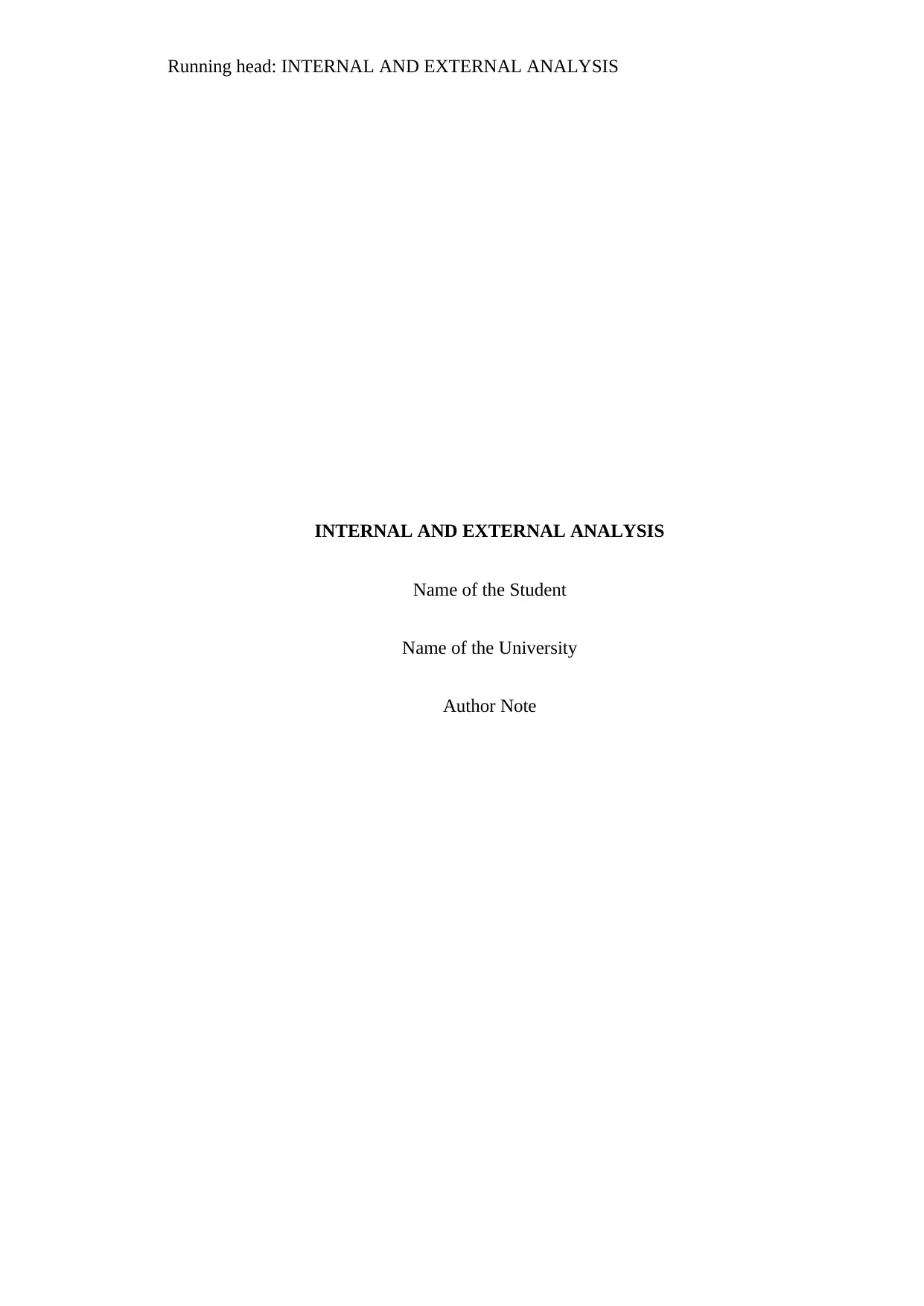
Running head: INTERNAL AND EXTERNAL ANALYSIS
INTERNAL AND EXTERNAL ANALYSIS
Name of the Student
Name of the University
Author Note
INTERNAL AND EXTERNAL ANALYSIS
Name of the Student
Name of the University
Author Note
Paraphrase This Document
Need a fresh take? Get an instant paraphrase of this document with our AI Paraphraser
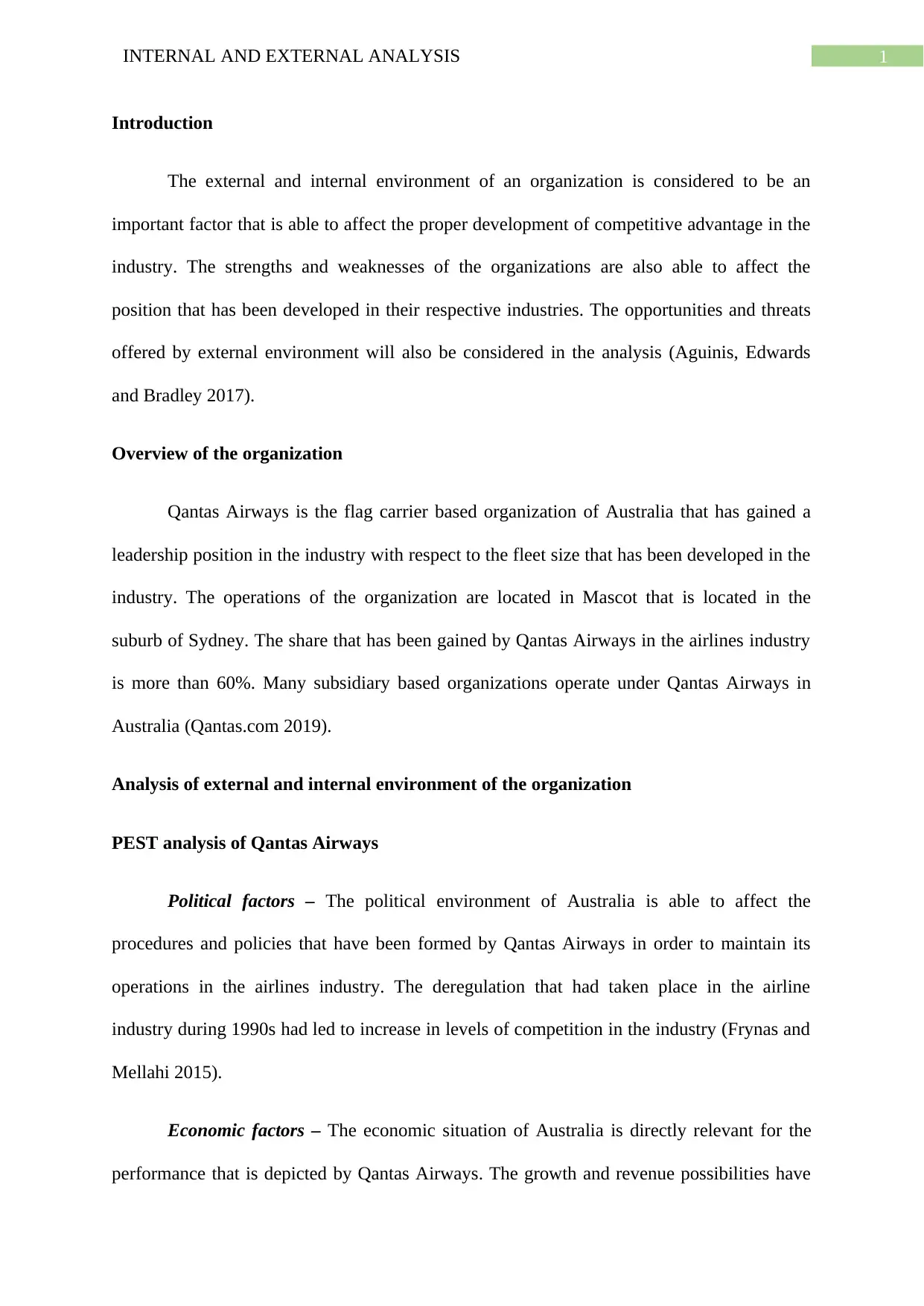
1INTERNAL AND EXTERNAL ANALYSIS
Introduction
The external and internal environment of an organization is considered to be an
important factor that is able to affect the proper development of competitive advantage in the
industry. The strengths and weaknesses of the organizations are also able to affect the
position that has been developed in their respective industries. The opportunities and threats
offered by external environment will also be considered in the analysis (Aguinis, Edwards
and Bradley 2017).
Overview of the organization
Qantas Airways is the flag carrier based organization of Australia that has gained a
leadership position in the industry with respect to the fleet size that has been developed in the
industry. The operations of the organization are located in Mascot that is located in the
suburb of Sydney. The share that has been gained by Qantas Airways in the airlines industry
is more than 60%. Many subsidiary based organizations operate under Qantas Airways in
Australia (Qantas.com 2019).
Analysis of external and internal environment of the organization
PEST analysis of Qantas Airways
Political factors – The political environment of Australia is able to affect the
procedures and policies that have been formed by Qantas Airways in order to maintain its
operations in the airlines industry. The deregulation that had taken place in the airline
industry during 1990s had led to increase in levels of competition in the industry (Frynas and
Mellahi 2015).
Economic factors – The economic situation of Australia is directly relevant for the
performance that is depicted by Qantas Airways. The growth and revenue possibilities have
Introduction
The external and internal environment of an organization is considered to be an
important factor that is able to affect the proper development of competitive advantage in the
industry. The strengths and weaknesses of the organizations are also able to affect the
position that has been developed in their respective industries. The opportunities and threats
offered by external environment will also be considered in the analysis (Aguinis, Edwards
and Bradley 2017).
Overview of the organization
Qantas Airways is the flag carrier based organization of Australia that has gained a
leadership position in the industry with respect to the fleet size that has been developed in the
industry. The operations of the organization are located in Mascot that is located in the
suburb of Sydney. The share that has been gained by Qantas Airways in the airlines industry
is more than 60%. Many subsidiary based organizations operate under Qantas Airways in
Australia (Qantas.com 2019).
Analysis of external and internal environment of the organization
PEST analysis of Qantas Airways
Political factors – The political environment of Australia is able to affect the
procedures and policies that have been formed by Qantas Airways in order to maintain its
operations in the airlines industry. The deregulation that had taken place in the airline
industry during 1990s had led to increase in levels of competition in the industry (Frynas and
Mellahi 2015).
Economic factors – The economic situation of Australia is directly relevant for the
performance that is depicted by Qantas Airways. The growth and revenue possibilities have
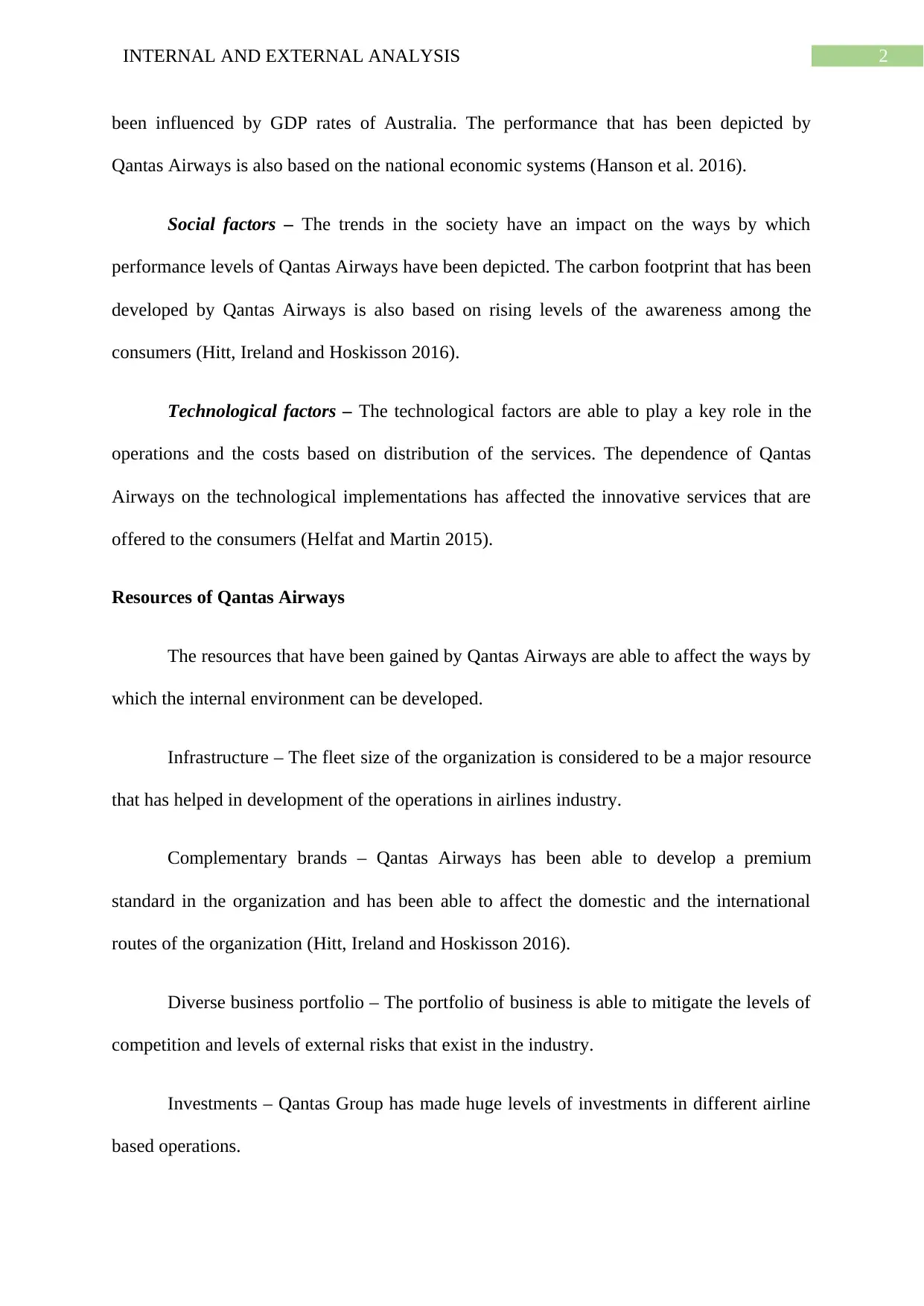
2INTERNAL AND EXTERNAL ANALYSIS
been influenced by GDP rates of Australia. The performance that has been depicted by
Qantas Airways is also based on the national economic systems (Hanson et al. 2016).
Social factors – The trends in the society have an impact on the ways by which
performance levels of Qantas Airways have been depicted. The carbon footprint that has been
developed by Qantas Airways is also based on rising levels of the awareness among the
consumers (Hitt, Ireland and Hoskisson 2016).
Technological factors – The technological factors are able to play a key role in the
operations and the costs based on distribution of the services. The dependence of Qantas
Airways on the technological implementations has affected the innovative services that are
offered to the consumers (Helfat and Martin 2015).
Resources of Qantas Airways
The resources that have been gained by Qantas Airways are able to affect the ways by
which the internal environment can be developed.
Infrastructure – The fleet size of the organization is considered to be a major resource
that has helped in development of the operations in airlines industry.
Complementary brands – Qantas Airways has been able to develop a premium
standard in the organization and has been able to affect the domestic and the international
routes of the organization (Hitt, Ireland and Hoskisson 2016).
Diverse business portfolio – The portfolio of business is able to mitigate the levels of
competition and levels of external risks that exist in the industry.
Investments – Qantas Group has made huge levels of investments in different airline
based operations.
been influenced by GDP rates of Australia. The performance that has been depicted by
Qantas Airways is also based on the national economic systems (Hanson et al. 2016).
Social factors – The trends in the society have an impact on the ways by which
performance levels of Qantas Airways have been depicted. The carbon footprint that has been
developed by Qantas Airways is also based on rising levels of the awareness among the
consumers (Hitt, Ireland and Hoskisson 2016).
Technological factors – The technological factors are able to play a key role in the
operations and the costs based on distribution of the services. The dependence of Qantas
Airways on the technological implementations has affected the innovative services that are
offered to the consumers (Helfat and Martin 2015).
Resources of Qantas Airways
The resources that have been gained by Qantas Airways are able to affect the ways by
which the internal environment can be developed.
Infrastructure – The fleet size of the organization is considered to be a major resource
that has helped in development of the operations in airlines industry.
Complementary brands – Qantas Airways has been able to develop a premium
standard in the organization and has been able to affect the domestic and the international
routes of the organization (Hitt, Ireland and Hoskisson 2016).
Diverse business portfolio – The portfolio of business is able to mitigate the levels of
competition and levels of external risks that exist in the industry.
Investments – Qantas Group has made huge levels of investments in different airline
based operations.
⊘ This is a preview!⊘
Do you want full access?
Subscribe today to unlock all pages.

Trusted by 1+ million students worldwide
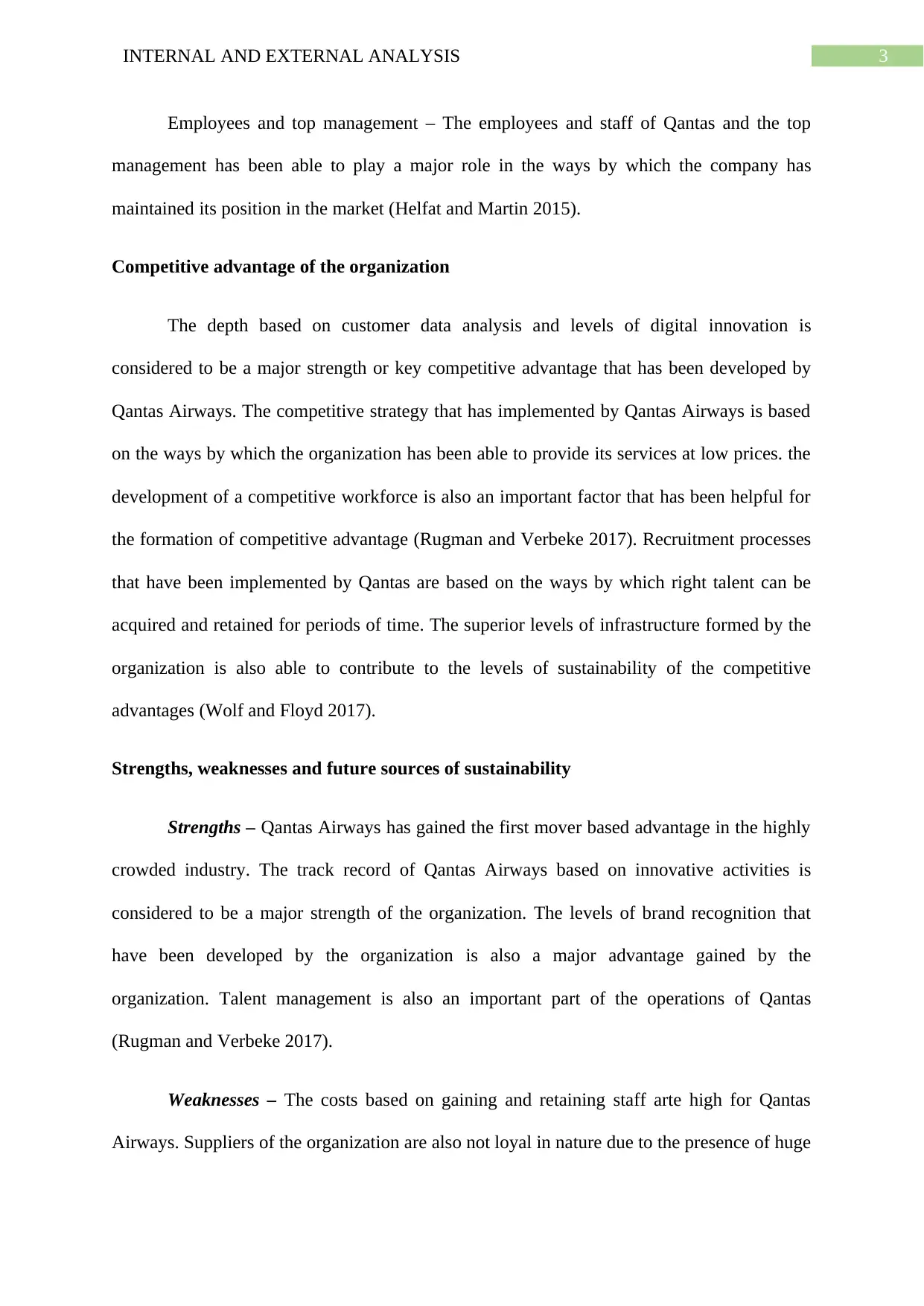
3INTERNAL AND EXTERNAL ANALYSIS
Employees and top management – The employees and staff of Qantas and the top
management has been able to play a major role in the ways by which the company has
maintained its position in the market (Helfat and Martin 2015).
Competitive advantage of the organization
The depth based on customer data analysis and levels of digital innovation is
considered to be a major strength or key competitive advantage that has been developed by
Qantas Airways. The competitive strategy that has implemented by Qantas Airways is based
on the ways by which the organization has been able to provide its services at low prices. the
development of a competitive workforce is also an important factor that has been helpful for
the formation of competitive advantage (Rugman and Verbeke 2017). Recruitment processes
that have been implemented by Qantas are based on the ways by which right talent can be
acquired and retained for periods of time. The superior levels of infrastructure formed by the
organization is also able to contribute to the levels of sustainability of the competitive
advantages (Wolf and Floyd 2017).
Strengths, weaknesses and future sources of sustainability
Strengths – Qantas Airways has gained the first mover based advantage in the highly
crowded industry. The track record of Qantas Airways based on innovative activities is
considered to be a major strength of the organization. The levels of brand recognition that
have been developed by the organization is also a major advantage gained by the
organization. Talent management is also an important part of the operations of Qantas
(Rugman and Verbeke 2017).
Weaknesses – The costs based on gaining and retaining staff arte high for Qantas
Airways. Suppliers of the organization are also not loyal in nature due to the presence of huge
Employees and top management – The employees and staff of Qantas and the top
management has been able to play a major role in the ways by which the company has
maintained its position in the market (Helfat and Martin 2015).
Competitive advantage of the organization
The depth based on customer data analysis and levels of digital innovation is
considered to be a major strength or key competitive advantage that has been developed by
Qantas Airways. The competitive strategy that has implemented by Qantas Airways is based
on the ways by which the organization has been able to provide its services at low prices. the
development of a competitive workforce is also an important factor that has been helpful for
the formation of competitive advantage (Rugman and Verbeke 2017). Recruitment processes
that have been implemented by Qantas are based on the ways by which right talent can be
acquired and retained for periods of time. The superior levels of infrastructure formed by the
organization is also able to contribute to the levels of sustainability of the competitive
advantages (Wolf and Floyd 2017).
Strengths, weaknesses and future sources of sustainability
Strengths – Qantas Airways has gained the first mover based advantage in the highly
crowded industry. The track record of Qantas Airways based on innovative activities is
considered to be a major strength of the organization. The levels of brand recognition that
have been developed by the organization is also a major advantage gained by the
organization. Talent management is also an important part of the operations of Qantas
(Rugman and Verbeke 2017).
Weaknesses – The costs based on gaining and retaining staff arte high for Qantas
Airways. Suppliers of the organization are also not loyal in nature due to the presence of huge
Paraphrase This Document
Need a fresh take? Get an instant paraphrase of this document with our AI Paraphraser
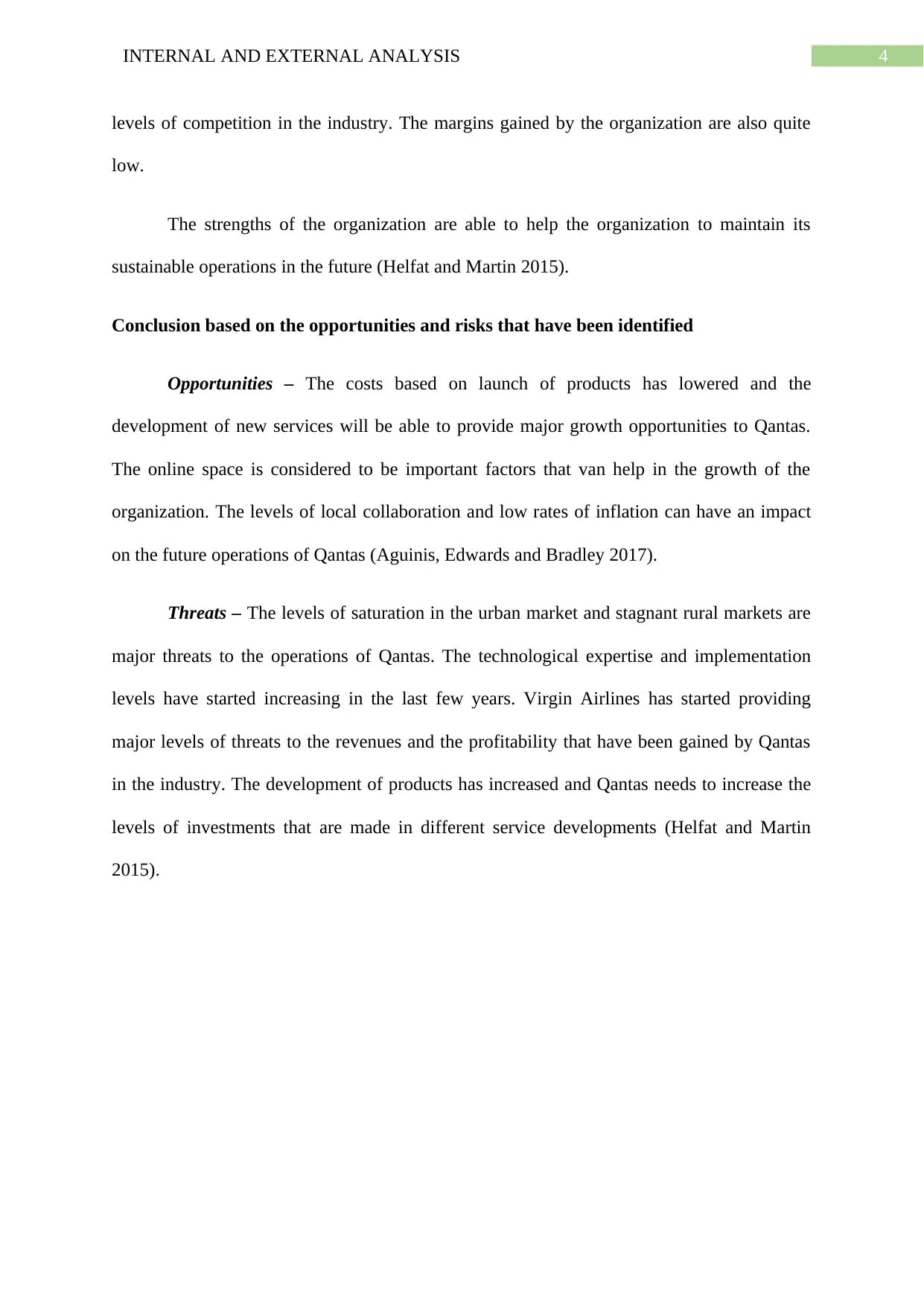
4INTERNAL AND EXTERNAL ANALYSIS
levels of competition in the industry. The margins gained by the organization are also quite
low.
The strengths of the organization are able to help the organization to maintain its
sustainable operations in the future (Helfat and Martin 2015).
Conclusion based on the opportunities and risks that have been identified
Opportunities – The costs based on launch of products has lowered and the
development of new services will be able to provide major growth opportunities to Qantas.
The online space is considered to be important factors that van help in the growth of the
organization. The levels of local collaboration and low rates of inflation can have an impact
on the future operations of Qantas (Aguinis, Edwards and Bradley 2017).
Threats – The levels of saturation in the urban market and stagnant rural markets are
major threats to the operations of Qantas. The technological expertise and implementation
levels have started increasing in the last few years. Virgin Airlines has started providing
major levels of threats to the revenues and the profitability that have been gained by Qantas
in the industry. The development of products has increased and Qantas needs to increase the
levels of investments that are made in different service developments (Helfat and Martin
2015).
levels of competition in the industry. The margins gained by the organization are also quite
low.
The strengths of the organization are able to help the organization to maintain its
sustainable operations in the future (Helfat and Martin 2015).
Conclusion based on the opportunities and risks that have been identified
Opportunities – The costs based on launch of products has lowered and the
development of new services will be able to provide major growth opportunities to Qantas.
The online space is considered to be important factors that van help in the growth of the
organization. The levels of local collaboration and low rates of inflation can have an impact
on the future operations of Qantas (Aguinis, Edwards and Bradley 2017).
Threats – The levels of saturation in the urban market and stagnant rural markets are
major threats to the operations of Qantas. The technological expertise and implementation
levels have started increasing in the last few years. Virgin Airlines has started providing
major levels of threats to the revenues and the profitability that have been gained by Qantas
in the industry. The development of products has increased and Qantas needs to increase the
levels of investments that are made in different service developments (Helfat and Martin
2015).
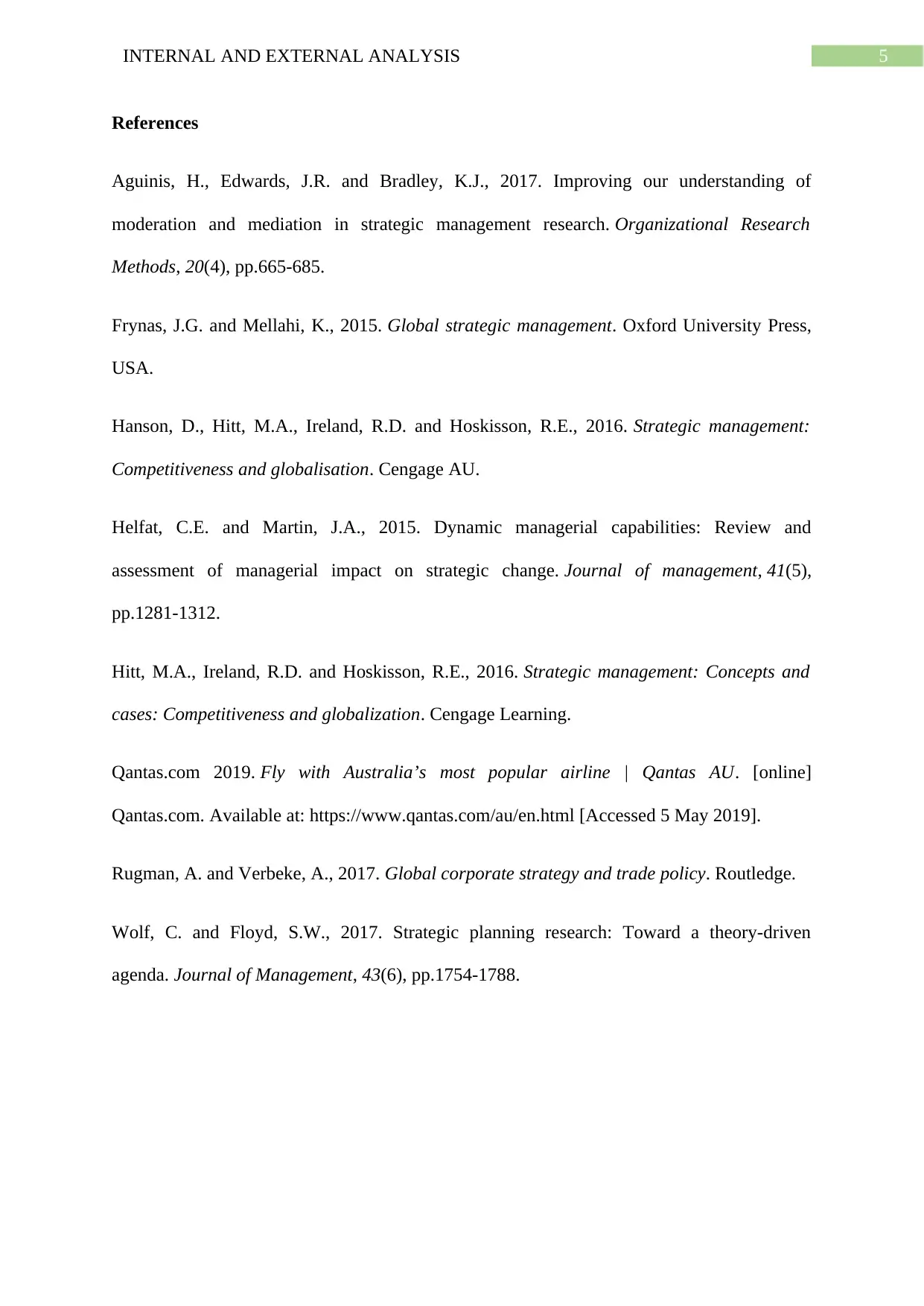
5INTERNAL AND EXTERNAL ANALYSIS
References
Aguinis, H., Edwards, J.R. and Bradley, K.J., 2017. Improving our understanding of
moderation and mediation in strategic management research. Organizational Research
Methods, 20(4), pp.665-685.
Frynas, J.G. and Mellahi, K., 2015. Global strategic management. Oxford University Press,
USA.
Hanson, D., Hitt, M.A., Ireland, R.D. and Hoskisson, R.E., 2016. Strategic management:
Competitiveness and globalisation. Cengage AU.
Helfat, C.E. and Martin, J.A., 2015. Dynamic managerial capabilities: Review and
assessment of managerial impact on strategic change. Journal of management, 41(5),
pp.1281-1312.
Hitt, M.A., Ireland, R.D. and Hoskisson, R.E., 2016. Strategic management: Concepts and
cases: Competitiveness and globalization. Cengage Learning.
Qantas.com 2019. Fly with Australia’s most popular airline | Qantas AU. [online]
Qantas.com. Available at: https://www.qantas.com/au/en.html [Accessed 5 May 2019].
Rugman, A. and Verbeke, A., 2017. Global corporate strategy and trade policy. Routledge.
Wolf, C. and Floyd, S.W., 2017. Strategic planning research: Toward a theory-driven
agenda. Journal of Management, 43(6), pp.1754-1788.
References
Aguinis, H., Edwards, J.R. and Bradley, K.J., 2017. Improving our understanding of
moderation and mediation in strategic management research. Organizational Research
Methods, 20(4), pp.665-685.
Frynas, J.G. and Mellahi, K., 2015. Global strategic management. Oxford University Press,
USA.
Hanson, D., Hitt, M.A., Ireland, R.D. and Hoskisson, R.E., 2016. Strategic management:
Competitiveness and globalisation. Cengage AU.
Helfat, C.E. and Martin, J.A., 2015. Dynamic managerial capabilities: Review and
assessment of managerial impact on strategic change. Journal of management, 41(5),
pp.1281-1312.
Hitt, M.A., Ireland, R.D. and Hoskisson, R.E., 2016. Strategic management: Concepts and
cases: Competitiveness and globalization. Cengage Learning.
Qantas.com 2019. Fly with Australia’s most popular airline | Qantas AU. [online]
Qantas.com. Available at: https://www.qantas.com/au/en.html [Accessed 5 May 2019].
Rugman, A. and Verbeke, A., 2017. Global corporate strategy and trade policy. Routledge.
Wolf, C. and Floyd, S.W., 2017. Strategic planning research: Toward a theory-driven
agenda. Journal of Management, 43(6), pp.1754-1788.
⊘ This is a preview!⊘
Do you want full access?
Subscribe today to unlock all pages.

Trusted by 1+ million students worldwide
1 out of 6
Related Documents
Your All-in-One AI-Powered Toolkit for Academic Success.
+13062052269
info@desklib.com
Available 24*7 on WhatsApp / Email
![[object Object]](/_next/static/media/star-bottom.7253800d.svg)
Unlock your academic potential
Copyright © 2020–2025 A2Z Services. All Rights Reserved. Developed and managed by ZUCOL.





